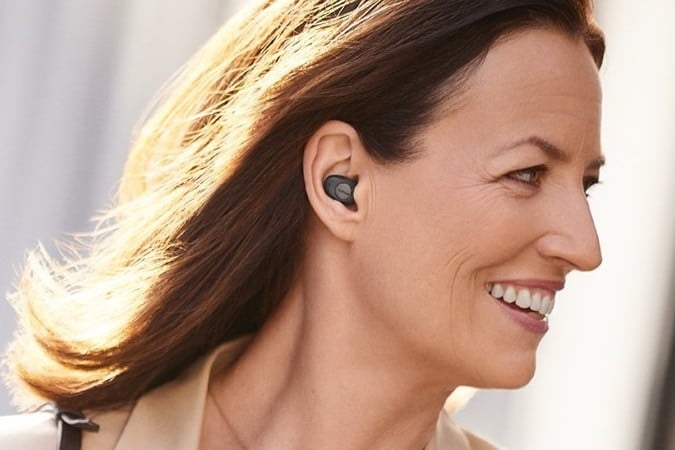Jabra last year announced its Enhance Plus true wireless earbuds — the first from the company to incorporate hearing aid technology, They are aimed at giving folks with mild to moderate hearing loss many of the benefits of medical-grade hearing aids in a design that looks no different than the hundreds of other wireless earbuds on the market. We now know how much they’ll cost ($799) and when folks will be able to buy them in the U.S. (February 25, 2022, only at select hearing care clinics).
The new earbuds, which come in dark gray or gold beige, have four sound-processing features designed to improve how you hear in a variety of settings like restaurants and work meetings. According to Jabra, they are:
- Warp Compressor: Analyzes sounds similarly to the human ear for more natural sound quality.
- Digital Noise Reduction: Provides listening comfort and keeps speech clear in various noise environments.
- Digital Feedback Suppression: Keeps feedback from interfering with quality amplification of sound.
- Binaural Beamformer (with directionality): Isolates sounds coming in front of you, allowing users to focus on what is important.
In practice, there are three modes that can be used for hearing enhancement: Adaptive, Focus, and Surround. Adaptive is somewhat like an automatic function, with the earbuds attempting to guess at the kind of enhancement you need at any given time, while Focus lets you target nearby conversations and Surround lets you bring in a wider area of sounds around you.
What’s remarkable about the Enhance Plus — beyond their hearing-enhancement capabilities — is their size. Jabra claims they’re 40% smaller than the company’s Elite 7 Pro true wireless earbuds, which are already among the smallest you can buy. “Their extremely small size makes them virtually unnoticeable, even in conversations,” notes Jabra’s press release.
Yet despite their tiny size and hearing benefits, the Enhance Plus operate just like any other Bluetooth true wireless earbuds, with 10 hours of battery life on a single charge and an additional 30 hours in their charging case. They’re IP52-rated for decent protection from both water and dust, and they use a “high-quality codec for strong streaming sound quality,” though Jabra still hasn’t indicated which codec. The company’s Elite 7 Pro and Elite 85t both use fairly standard SBC and AAC codecs.
The $499 Nuheara IQbuds2 Max offer a similar combination of features, but stop short of promising true medical-grade enhancement.

There’s just one catch, but it’s kind of a big one. Because the Enhance Plus are considered a medical device, they require a visit to a licensed hearing care professional, where you’ll have to take a medical hearing test and assessment. If at that point, the Jabra Enhance Plus is determined to be appropriate for your needs, you’ll be able to buy them in person.
However, the U.S. is on the cusp of approving a new regulation that will let Jabra sell the Enhance Plus direct to buyers just like the Bose SoundControl Hearing Aids. And the Enhance Plus have already been 510(k)-cleared with the Food and Drug Administration (FDA) under the self-fit hearing aid regulation in anticipation of that regulation coming into effect.
“When the new [over-the-counter] regulation comes into effect, we look forward to be there to help people with solutions that provide better situational hearing, as well as music and calls in modern and stylish designs”, Jabra CEO, René Svendsen-Tune, said in a press release.
Along with the earbuds, you’ll get the Jabra Enhance app, which Jabra says will offer an easy one-time setup experience that can be completed in minutes (this will presumably be the way Jabra lets people eventually fit the earbuds without the help of an audiologist). The app also offers simple controls to adjust volume and listening mode for any environment.
Given that the Enhance Plus were developed in collaboration with Jabra’s sister company — GN Hearing, the company behind some of the most widely used medical-grade hearing aids — there’s good reason to think these earbuds will offer a meaningful improvement in hearing for those who suffer from hearing loss.
Editors’ Recommendations

